Comparative Study of Sewage Treatment Plants: Werribee and Carrum
VerifiedAdded on 2020/06/04
|10
|2709
|246
Report
AI Summary
This report provides a comprehensive overview of the sewage treatment processes employed at the Western Treatment Plant (Werribee) and the Eastern Treatment Plant (Carrum) in Melbourne, Australia. It explores the historical context, operational details, and environmental impacts of these large-scale facilities. The report details the three traditional treatment methods used at Werribee: land filtration, grass filtration, and lagoon treatment, including their stages and mechanisms. It contrasts these with the primary, secondary, and tertiary treatment stages at Carrum, highlighting the different technologies and objectives of each plant. The report also addresses the challenges faced by both plants, such as reduced sewer flow and pipeline corrosion, and discusses potential solutions like improved filtration and the use of bacteria. Furthermore, it evaluates the environmental consequences, including the impact on local ecosystems and the benefits of recycling treated water, emphasizing the importance of sustainable sewage management practices.
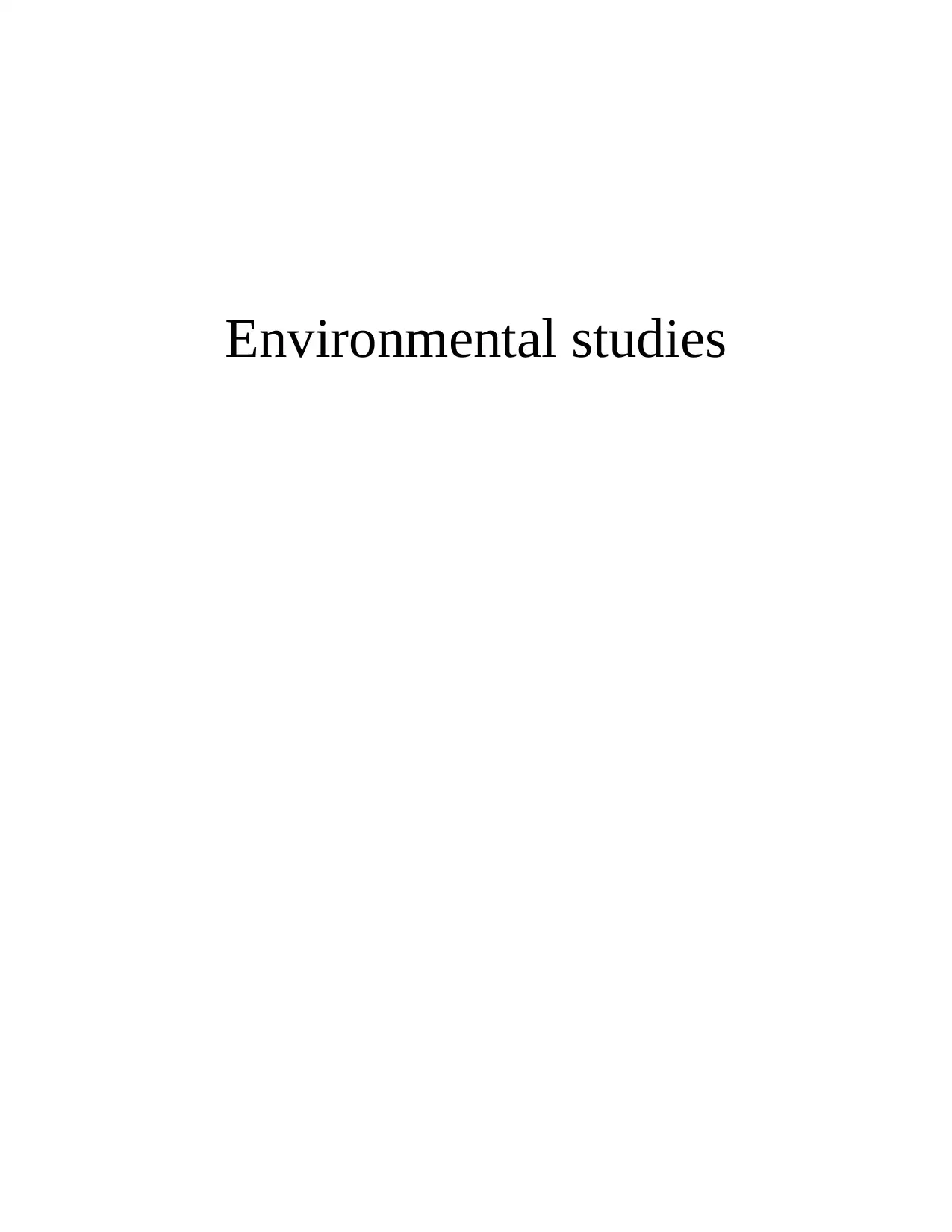
Environmental studies
Paraphrase This Document
Need a fresh take? Get an instant paraphrase of this document with our AI Paraphraser
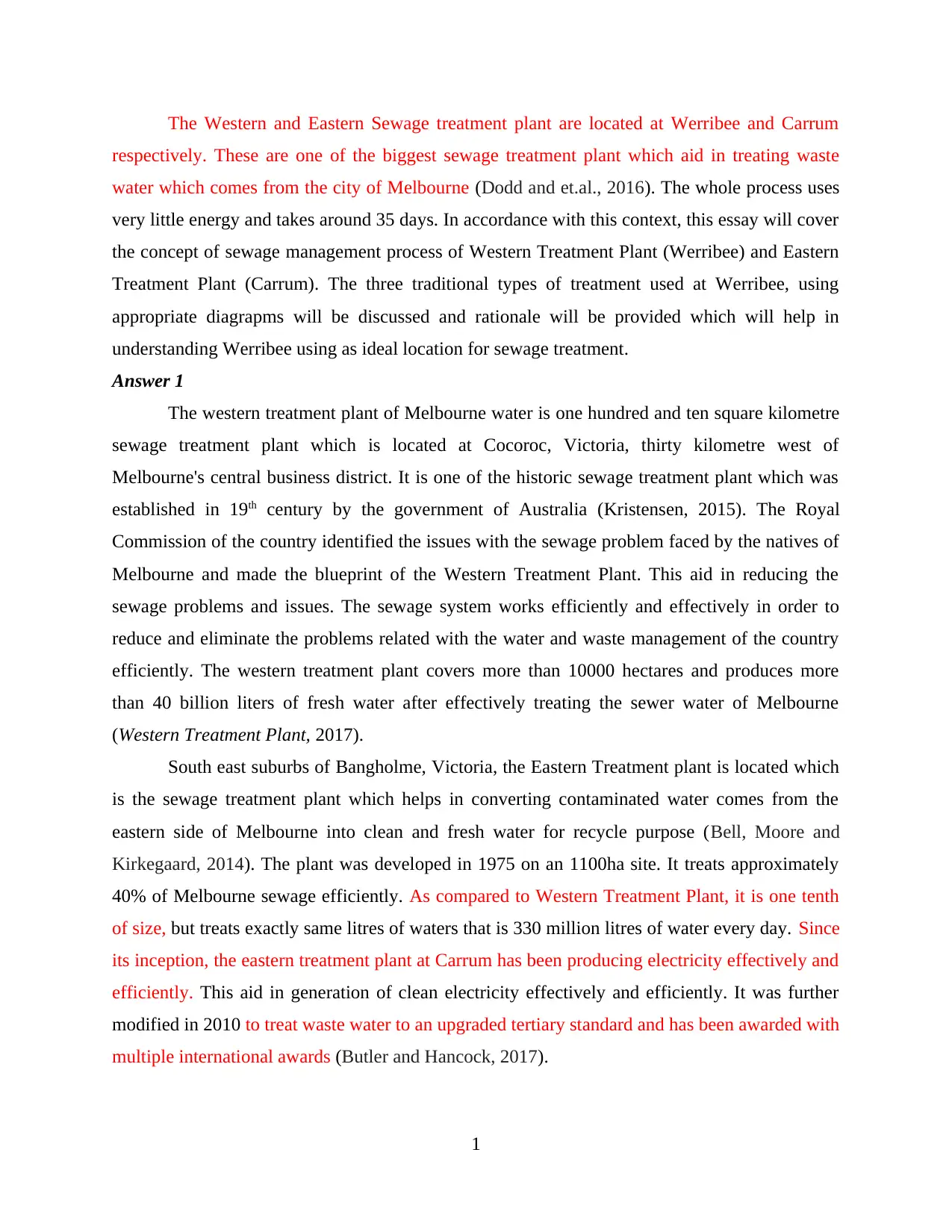
The Western and Eastern Sewage treatment plant are located at Werribee and Carrum
respectively. These are one of the biggest sewage treatment plant which aid in treating waste
water which comes from the city of Melbourne (Dodd and et.al., 2016). The whole process uses
very little energy and takes around 35 days. In accordance with this context, this essay will cover
the concept of sewage management process of Western Treatment Plant (Werribee) and Eastern
Treatment Plant (Carrum). The three traditional types of treatment used at Werribee, using
appropriate diagrapms will be discussed and rationale will be provided which will help in
understanding Werribee using as ideal location for sewage treatment.
Answer 1
The western treatment plant of Melbourne water is one hundred and ten square kilometre
sewage treatment plant which is located at Cocoroc, Victoria, thirty kilometre west of
Melbourne's central business district. It is one of the historic sewage treatment plant which was
established in 19th century by the government of Australia (Kristensen, 2015). The Royal
Commission of the country identified the issues with the sewage problem faced by the natives of
Melbourne and made the blueprint of the Western Treatment Plant. This aid in reducing the
sewage problems and issues. The sewage system works efficiently and effectively in order to
reduce and eliminate the problems related with the water and waste management of the country
efficiently. The western treatment plant covers more than 10000 hectares and produces more
than 40 billion liters of fresh water after effectively treating the sewer water of Melbourne
(Western Treatment Plant, 2017).
South east suburbs of Bangholme, Victoria, the Eastern Treatment plant is located which
is the sewage treatment plant which helps in converting contaminated water comes from the
eastern side of Melbourne into clean and fresh water for recycle purpose (Bell, Moore and
Kirkegaard, 2014). The plant was developed in 1975 on an 1100ha site. It treats approximately
40% of Melbourne sewage efficiently. As compared to Western Treatment Plant, it is one tenth
of size, but treats exactly same litres of waters that is 330 million litres of water every day. Since
its inception, the eastern treatment plant at Carrum has been producing electricity effectively and
efficiently. This aid in generation of clean electricity effectively and efficiently. It was further
modified in 2010 to treat waste water to an upgraded tertiary standard and has been awarded with
multiple international awards (Butler and Hancock, 2017).
1
respectively. These are one of the biggest sewage treatment plant which aid in treating waste
water which comes from the city of Melbourne (Dodd and et.al., 2016). The whole process uses
very little energy and takes around 35 days. In accordance with this context, this essay will cover
the concept of sewage management process of Western Treatment Plant (Werribee) and Eastern
Treatment Plant (Carrum). The three traditional types of treatment used at Werribee, using
appropriate diagrapms will be discussed and rationale will be provided which will help in
understanding Werribee using as ideal location for sewage treatment.
Answer 1
The western treatment plant of Melbourne water is one hundred and ten square kilometre
sewage treatment plant which is located at Cocoroc, Victoria, thirty kilometre west of
Melbourne's central business district. It is one of the historic sewage treatment plant which was
established in 19th century by the government of Australia (Kristensen, 2015). The Royal
Commission of the country identified the issues with the sewage problem faced by the natives of
Melbourne and made the blueprint of the Western Treatment Plant. This aid in reducing the
sewage problems and issues. The sewage system works efficiently and effectively in order to
reduce and eliminate the problems related with the water and waste management of the country
efficiently. The western treatment plant covers more than 10000 hectares and produces more
than 40 billion liters of fresh water after effectively treating the sewer water of Melbourne
(Western Treatment Plant, 2017).
South east suburbs of Bangholme, Victoria, the Eastern Treatment plant is located which
is the sewage treatment plant which helps in converting contaminated water comes from the
eastern side of Melbourne into clean and fresh water for recycle purpose (Bell, Moore and
Kirkegaard, 2014). The plant was developed in 1975 on an 1100ha site. It treats approximately
40% of Melbourne sewage efficiently. As compared to Western Treatment Plant, it is one tenth
of size, but treats exactly same litres of waters that is 330 million litres of water every day. Since
its inception, the eastern treatment plant at Carrum has been producing electricity effectively and
efficiently. This aid in generation of clean electricity effectively and efficiently. It was further
modified in 2010 to treat waste water to an upgraded tertiary standard and has been awarded with
multiple international awards (Butler and Hancock, 2017).
1
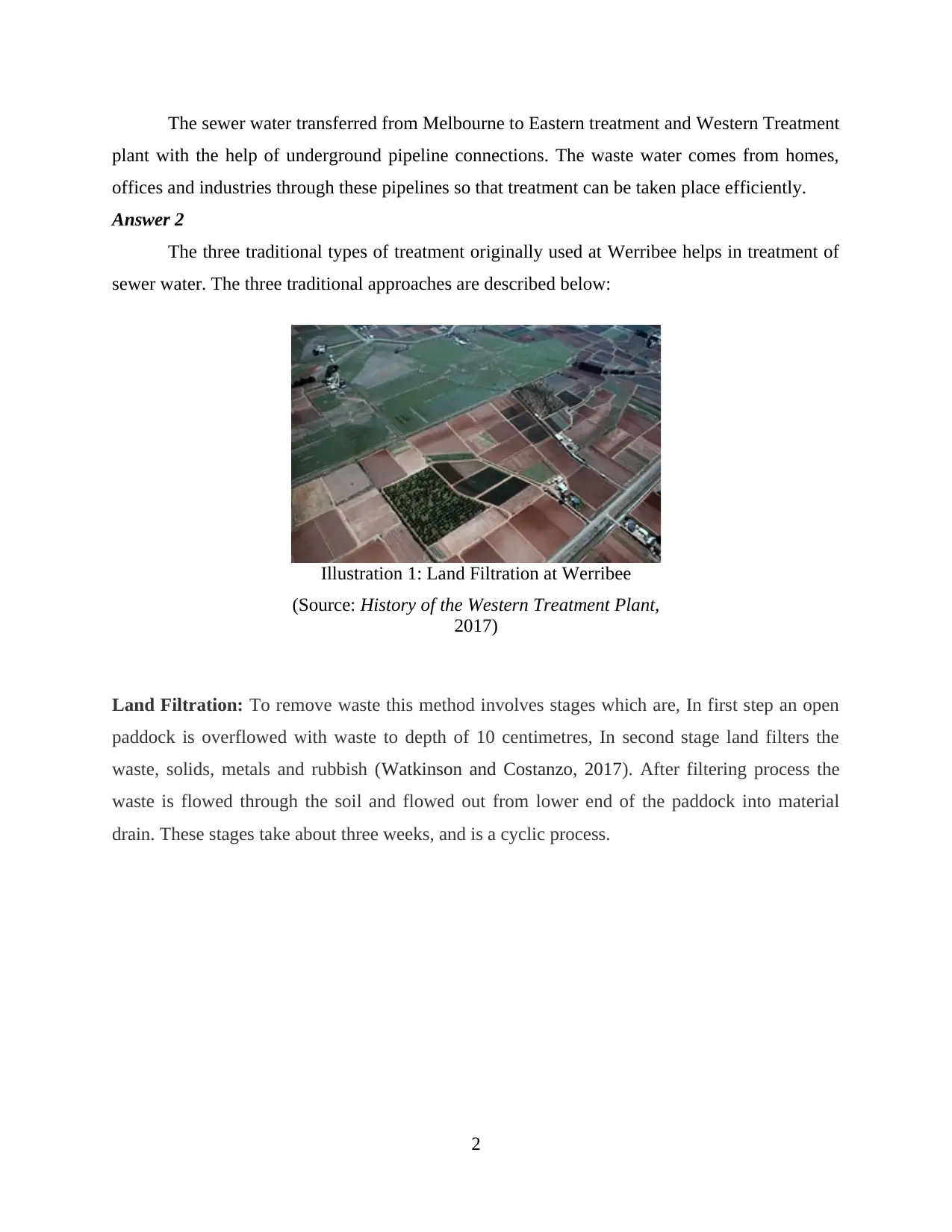
The sewer water transferred from Melbourne to Eastern treatment and Western Treatment
plant with the help of underground pipeline connections. The waste water comes from homes,
offices and industries through these pipelines so that treatment can be taken place efficiently.
Answer 2
The three traditional types of treatment originally used at Werribee helps in treatment of
sewer water. The three traditional approaches are described below:
Land Filtration: To remove waste this method involves stages which are, In first step an open
paddock is overflowed with waste to depth of 10 centimetres, In second stage land filters the
waste, solids, metals and rubbish (Watkinson and Costanzo, 2017). After filtering process the
waste is flowed through the soil and flowed out from lower end of the paddock into material
drain. These stages take about three weeks, and is a cyclic process.
2
Illustration 1: Land Filtration at Werribee
(Source: History of the Western Treatment Plant,
2017)
plant with the help of underground pipeline connections. The waste water comes from homes,
offices and industries through these pipelines so that treatment can be taken place efficiently.
Answer 2
The three traditional types of treatment originally used at Werribee helps in treatment of
sewer water. The three traditional approaches are described below:
Land Filtration: To remove waste this method involves stages which are, In first step an open
paddock is overflowed with waste to depth of 10 centimetres, In second stage land filters the
waste, solids, metals and rubbish (Watkinson and Costanzo, 2017). After filtering process the
waste is flowed through the soil and flowed out from lower end of the paddock into material
drain. These stages take about three weeks, and is a cyclic process.
2
Illustration 1: Land Filtration at Werribee
(Source: History of the Western Treatment Plant,
2017)
⊘ This is a preview!⊘
Do you want full access?
Subscribe today to unlock all pages.

Trusted by 1+ million students worldwide
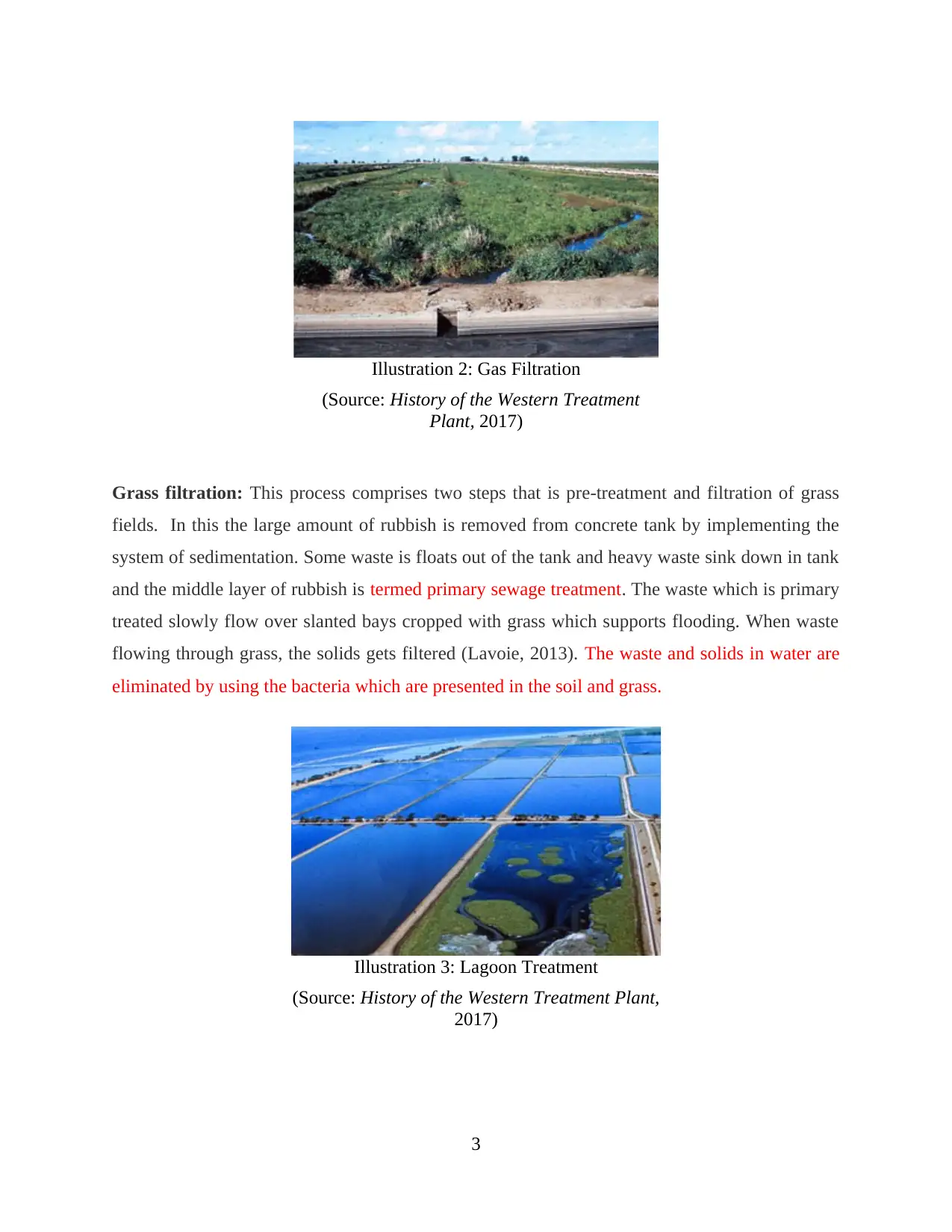
Grass filtration: This process comprises two steps that is pre-treatment and filtration of grass
fields. In this the large amount of rubbish is removed from concrete tank by implementing the
system of sedimentation. Some waste is floats out of the tank and heavy waste sink down in tank
and the middle layer of rubbish is termed primary sewage treatment. The waste which is primary
treated slowly flow over slanted bays cropped with grass which supports flooding. When waste
flowing through grass, the solids gets filtered (Lavoie, 2013). The waste and solids in water are
eliminated by using the bacteria which are presented in the soil and grass.
3
Illustration 2: Gas Filtration
(Source: History of the Western Treatment
Plant, 2017)
Illustration 3: Lagoon Treatment
(Source: History of the Western Treatment Plant,
2017)
fields. In this the large amount of rubbish is removed from concrete tank by implementing the
system of sedimentation. Some waste is floats out of the tank and heavy waste sink down in tank
and the middle layer of rubbish is termed primary sewage treatment. The waste which is primary
treated slowly flow over slanted bays cropped with grass which supports flooding. When waste
flowing through grass, the solids gets filtered (Lavoie, 2013). The waste and solids in water are
eliminated by using the bacteria which are presented in the soil and grass.
3
Illustration 2: Gas Filtration
(Source: History of the Western Treatment
Plant, 2017)
Illustration 3: Lagoon Treatment
(Source: History of the Western Treatment Plant,
2017)
Paraphrase This Document
Need a fresh take? Get an instant paraphrase of this document with our AI Paraphraser
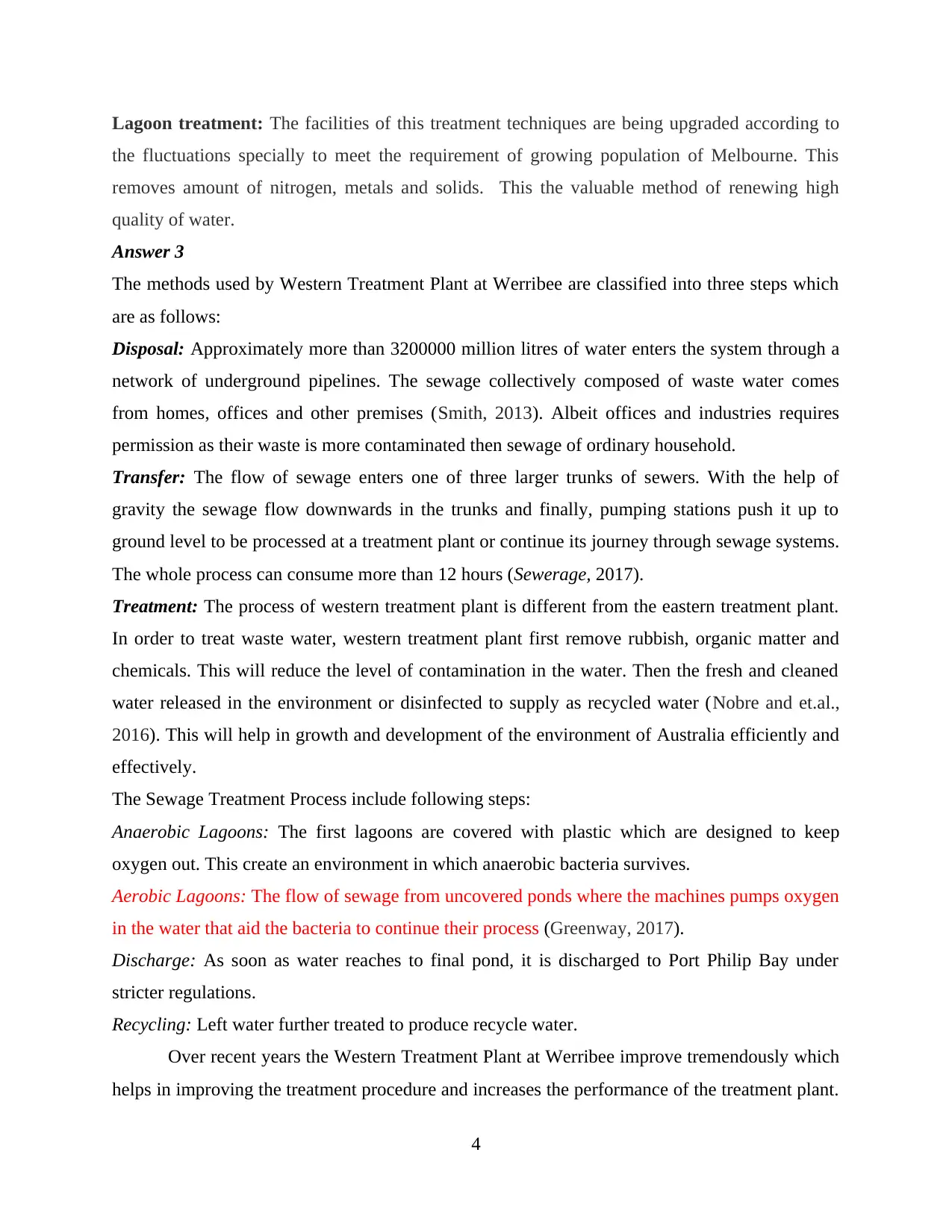
Lagoon treatment: The facilities of this treatment techniques are being upgraded according to
the fluctuations specially to meet the requirement of growing population of Melbourne. This
removes amount of nitrogen, metals and solids. This the valuable method of renewing high
quality of water.
Answer 3
The methods used by Western Treatment Plant at Werribee are classified into three steps which
are as follows:
Disposal: Approximately more than 3200000 million litres of water enters the system through a
network of underground pipelines. The sewage collectively composed of waste water comes
from homes, offices and other premises (Smith, 2013). Albeit offices and industries requires
permission as their waste is more contaminated then sewage of ordinary household.
Transfer: The flow of sewage enters one of three larger trunks of sewers. With the help of
gravity the sewage flow downwards in the trunks and finally, pumping stations push it up to
ground level to be processed at a treatment plant or continue its journey through sewage systems.
The whole process can consume more than 12 hours (Sewerage, 2017).
Treatment: The process of western treatment plant is different from the eastern treatment plant.
In order to treat waste water, western treatment plant first remove rubbish, organic matter and
chemicals. This will reduce the level of contamination in the water. Then the fresh and cleaned
water released in the environment or disinfected to supply as recycled water (Nobre and et.al.,
2016). This will help in growth and development of the environment of Australia efficiently and
effectively.
The Sewage Treatment Process include following steps:
Anaerobic Lagoons: The first lagoons are covered with plastic which are designed to keep
oxygen out. This create an environment in which anaerobic bacteria survives.
Aerobic Lagoons: The flow of sewage from uncovered ponds where the machines pumps oxygen
in the water that aid the bacteria to continue their process (Greenway, 2017).
Discharge: As soon as water reaches to final pond, it is discharged to Port Philip Bay under
stricter regulations.
Recycling: Left water further treated to produce recycle water.
Over recent years the Western Treatment Plant at Werribee improve tremendously which
helps in improving the treatment procedure and increases the performance of the treatment plant.
4
the fluctuations specially to meet the requirement of growing population of Melbourne. This
removes amount of nitrogen, metals and solids. This the valuable method of renewing high
quality of water.
Answer 3
The methods used by Western Treatment Plant at Werribee are classified into three steps which
are as follows:
Disposal: Approximately more than 3200000 million litres of water enters the system through a
network of underground pipelines. The sewage collectively composed of waste water comes
from homes, offices and other premises (Smith, 2013). Albeit offices and industries requires
permission as their waste is more contaminated then sewage of ordinary household.
Transfer: The flow of sewage enters one of three larger trunks of sewers. With the help of
gravity the sewage flow downwards in the trunks and finally, pumping stations push it up to
ground level to be processed at a treatment plant or continue its journey through sewage systems.
The whole process can consume more than 12 hours (Sewerage, 2017).
Treatment: The process of western treatment plant is different from the eastern treatment plant.
In order to treat waste water, western treatment plant first remove rubbish, organic matter and
chemicals. This will reduce the level of contamination in the water. Then the fresh and cleaned
water released in the environment or disinfected to supply as recycled water (Nobre and et.al.,
2016). This will help in growth and development of the environment of Australia efficiently and
effectively.
The Sewage Treatment Process include following steps:
Anaerobic Lagoons: The first lagoons are covered with plastic which are designed to keep
oxygen out. This create an environment in which anaerobic bacteria survives.
Aerobic Lagoons: The flow of sewage from uncovered ponds where the machines pumps oxygen
in the water that aid the bacteria to continue their process (Greenway, 2017).
Discharge: As soon as water reaches to final pond, it is discharged to Port Philip Bay under
stricter regulations.
Recycling: Left water further treated to produce recycle water.
Over recent years the Western Treatment Plant at Werribee improve tremendously which
helps in improving the treatment procedure and increases the performance of the treatment plant.
4
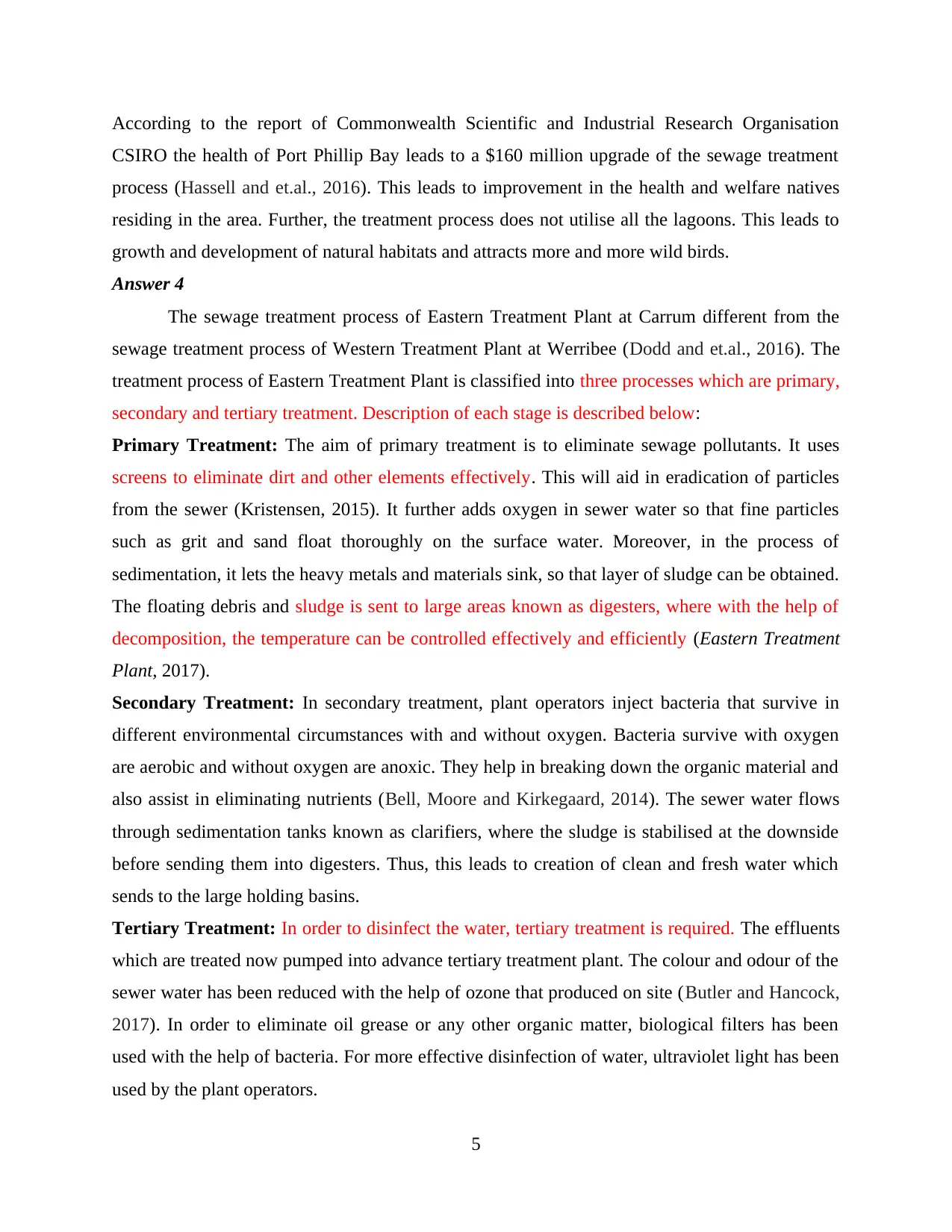
According to the report of Commonwealth Scientific and Industrial Research Organisation
CSIRO the health of Port Phillip Bay leads to a $160 million upgrade of the sewage treatment
process (Hassell and et.al., 2016). This leads to improvement in the health and welfare natives
residing in the area. Further, the treatment process does not utilise all the lagoons. This leads to
growth and development of natural habitats and attracts more and more wild birds.
Answer 4
The sewage treatment process of Eastern Treatment Plant at Carrum different from the
sewage treatment process of Western Treatment Plant at Werribee (Dodd and et.al., 2016). The
treatment process of Eastern Treatment Plant is classified into three processes which are primary,
secondary and tertiary treatment. Description of each stage is described below:
Primary Treatment: The aim of primary treatment is to eliminate sewage pollutants. It uses
screens to eliminate dirt and other elements effectively. This will aid in eradication of particles
from the sewer (Kristensen, 2015). It further adds oxygen in sewer water so that fine particles
such as grit and sand float thoroughly on the surface water. Moreover, in the process of
sedimentation, it lets the heavy metals and materials sink, so that layer of sludge can be obtained.
The floating debris and sludge is sent to large areas known as digesters, where with the help of
decomposition, the temperature can be controlled effectively and efficiently (Eastern Treatment
Plant, 2017).
Secondary Treatment: In secondary treatment, plant operators inject bacteria that survive in
different environmental circumstances with and without oxygen. Bacteria survive with oxygen
are aerobic and without oxygen are anoxic. They help in breaking down the organic material and
also assist in eliminating nutrients (Bell, Moore and Kirkegaard, 2014). The sewer water flows
through sedimentation tanks known as clarifiers, where the sludge is stabilised at the downside
before sending them into digesters. Thus, this leads to creation of clean and fresh water which
sends to the large holding basins.
Tertiary Treatment: In order to disinfect the water, tertiary treatment is required. The effluents
which are treated now pumped into advance tertiary treatment plant. The colour and odour of the
sewer water has been reduced with the help of ozone that produced on site (Butler and Hancock,
2017). In order to eliminate oil grease or any other organic matter, biological filters has been
used with the help of bacteria. For more effective disinfection of water, ultraviolet light has been
used by the plant operators.
5
CSIRO the health of Port Phillip Bay leads to a $160 million upgrade of the sewage treatment
process (Hassell and et.al., 2016). This leads to improvement in the health and welfare natives
residing in the area. Further, the treatment process does not utilise all the lagoons. This leads to
growth and development of natural habitats and attracts more and more wild birds.
Answer 4
The sewage treatment process of Eastern Treatment Plant at Carrum different from the
sewage treatment process of Western Treatment Plant at Werribee (Dodd and et.al., 2016). The
treatment process of Eastern Treatment Plant is classified into three processes which are primary,
secondary and tertiary treatment. Description of each stage is described below:
Primary Treatment: The aim of primary treatment is to eliminate sewage pollutants. It uses
screens to eliminate dirt and other elements effectively. This will aid in eradication of particles
from the sewer (Kristensen, 2015). It further adds oxygen in sewer water so that fine particles
such as grit and sand float thoroughly on the surface water. Moreover, in the process of
sedimentation, it lets the heavy metals and materials sink, so that layer of sludge can be obtained.
The floating debris and sludge is sent to large areas known as digesters, where with the help of
decomposition, the temperature can be controlled effectively and efficiently (Eastern Treatment
Plant, 2017).
Secondary Treatment: In secondary treatment, plant operators inject bacteria that survive in
different environmental circumstances with and without oxygen. Bacteria survive with oxygen
are aerobic and without oxygen are anoxic. They help in breaking down the organic material and
also assist in eliminating nutrients (Bell, Moore and Kirkegaard, 2014). The sewer water flows
through sedimentation tanks known as clarifiers, where the sludge is stabilised at the downside
before sending them into digesters. Thus, this leads to creation of clean and fresh water which
sends to the large holding basins.
Tertiary Treatment: In order to disinfect the water, tertiary treatment is required. The effluents
which are treated now pumped into advance tertiary treatment plant. The colour and odour of the
sewer water has been reduced with the help of ozone that produced on site (Butler and Hancock,
2017). In order to eliminate oil grease or any other organic matter, biological filters has been
used with the help of bacteria. For more effective disinfection of water, ultraviolet light has been
used by the plant operators.
5
⊘ This is a preview!⊘
Do you want full access?
Subscribe today to unlock all pages.

Trusted by 1+ million students worldwide
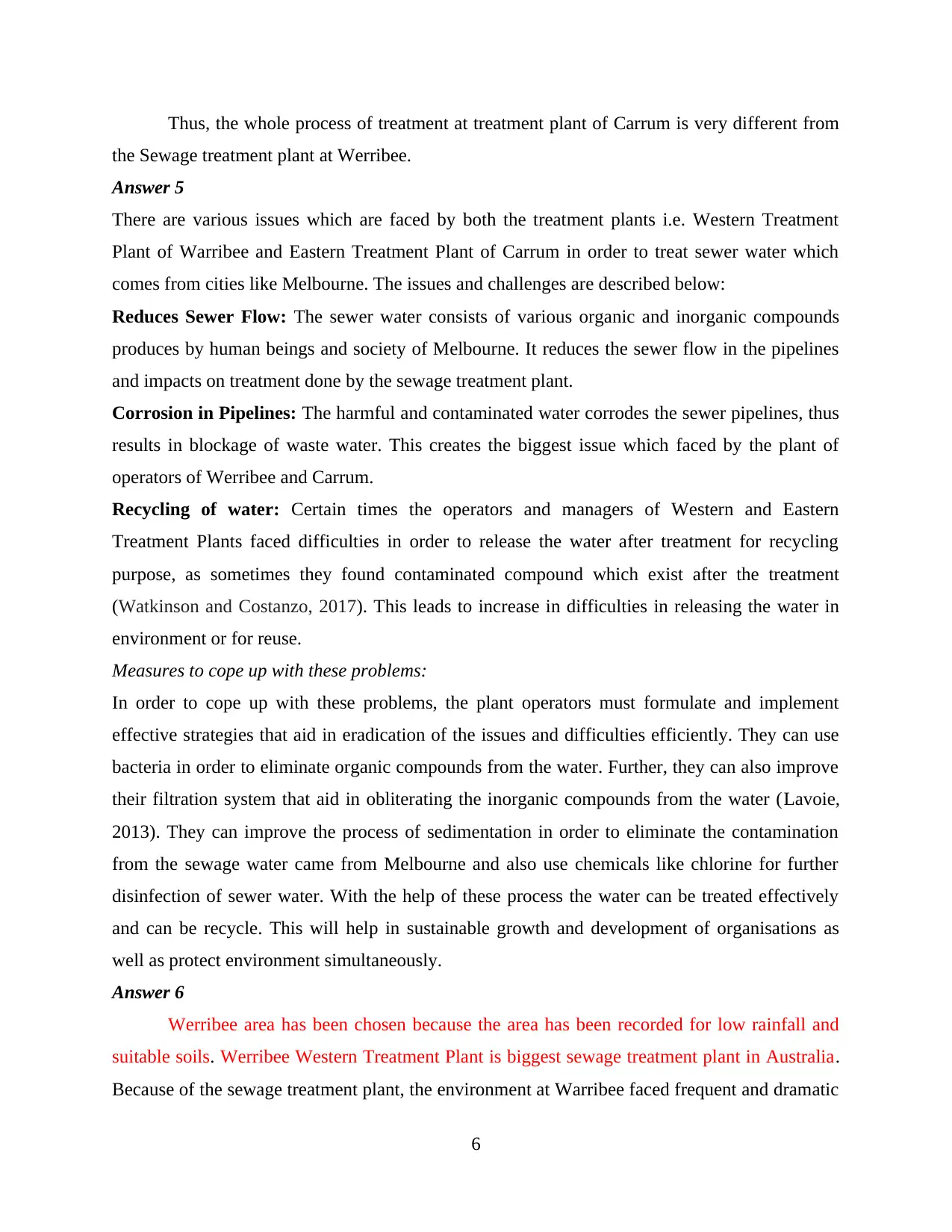
Thus, the whole process of treatment at treatment plant of Carrum is very different from
the Sewage treatment plant at Werribee.
Answer 5
There are various issues which are faced by both the treatment plants i.e. Western Treatment
Plant of Warribee and Eastern Treatment Plant of Carrum in order to treat sewer water which
comes from cities like Melbourne. The issues and challenges are described below:
Reduces Sewer Flow: The sewer water consists of various organic and inorganic compounds
produces by human beings and society of Melbourne. It reduces the sewer flow in the pipelines
and impacts on treatment done by the sewage treatment plant.
Corrosion in Pipelines: The harmful and contaminated water corrodes the sewer pipelines, thus
results in blockage of waste water. This creates the biggest issue which faced by the plant of
operators of Werribee and Carrum.
Recycling of water: Certain times the operators and managers of Western and Eastern
Treatment Plants faced difficulties in order to release the water after treatment for recycling
purpose, as sometimes they found contaminated compound which exist after the treatment
(Watkinson and Costanzo, 2017). This leads to increase in difficulties in releasing the water in
environment or for reuse.
Measures to cope up with these problems:
In order to cope up with these problems, the plant operators must formulate and implement
effective strategies that aid in eradication of the issues and difficulties efficiently. They can use
bacteria in order to eliminate organic compounds from the water. Further, they can also improve
their filtration system that aid in obliterating the inorganic compounds from the water (Lavoie,
2013). They can improve the process of sedimentation in order to eliminate the contamination
from the sewage water came from Melbourne and also use chemicals like chlorine for further
disinfection of sewer water. With the help of these process the water can be treated effectively
and can be recycle. This will help in sustainable growth and development of organisations as
well as protect environment simultaneously.
Answer 6
Werribee area has been chosen because the area has been recorded for low rainfall and
suitable soils. Werribee Western Treatment Plant is biggest sewage treatment plant in Australia.
Because of the sewage treatment plant, the environment at Warribee faced frequent and dramatic
6
the Sewage treatment plant at Werribee.
Answer 5
There are various issues which are faced by both the treatment plants i.e. Western Treatment
Plant of Warribee and Eastern Treatment Plant of Carrum in order to treat sewer water which
comes from cities like Melbourne. The issues and challenges are described below:
Reduces Sewer Flow: The sewer water consists of various organic and inorganic compounds
produces by human beings and society of Melbourne. It reduces the sewer flow in the pipelines
and impacts on treatment done by the sewage treatment plant.
Corrosion in Pipelines: The harmful and contaminated water corrodes the sewer pipelines, thus
results in blockage of waste water. This creates the biggest issue which faced by the plant of
operators of Werribee and Carrum.
Recycling of water: Certain times the operators and managers of Western and Eastern
Treatment Plants faced difficulties in order to release the water after treatment for recycling
purpose, as sometimes they found contaminated compound which exist after the treatment
(Watkinson and Costanzo, 2017). This leads to increase in difficulties in releasing the water in
environment or for reuse.
Measures to cope up with these problems:
In order to cope up with these problems, the plant operators must formulate and implement
effective strategies that aid in eradication of the issues and difficulties efficiently. They can use
bacteria in order to eliminate organic compounds from the water. Further, they can also improve
their filtration system that aid in obliterating the inorganic compounds from the water (Lavoie,
2013). They can improve the process of sedimentation in order to eliminate the contamination
from the sewage water came from Melbourne and also use chemicals like chlorine for further
disinfection of sewer water. With the help of these process the water can be treated effectively
and can be recycle. This will help in sustainable growth and development of organisations as
well as protect environment simultaneously.
Answer 6
Werribee area has been chosen because the area has been recorded for low rainfall and
suitable soils. Werribee Western Treatment Plant is biggest sewage treatment plant in Australia.
Because of the sewage treatment plant, the environment at Warribee faced frequent and dramatic
6
Paraphrase This Document
Need a fresh take? Get an instant paraphrase of this document with our AI Paraphraser
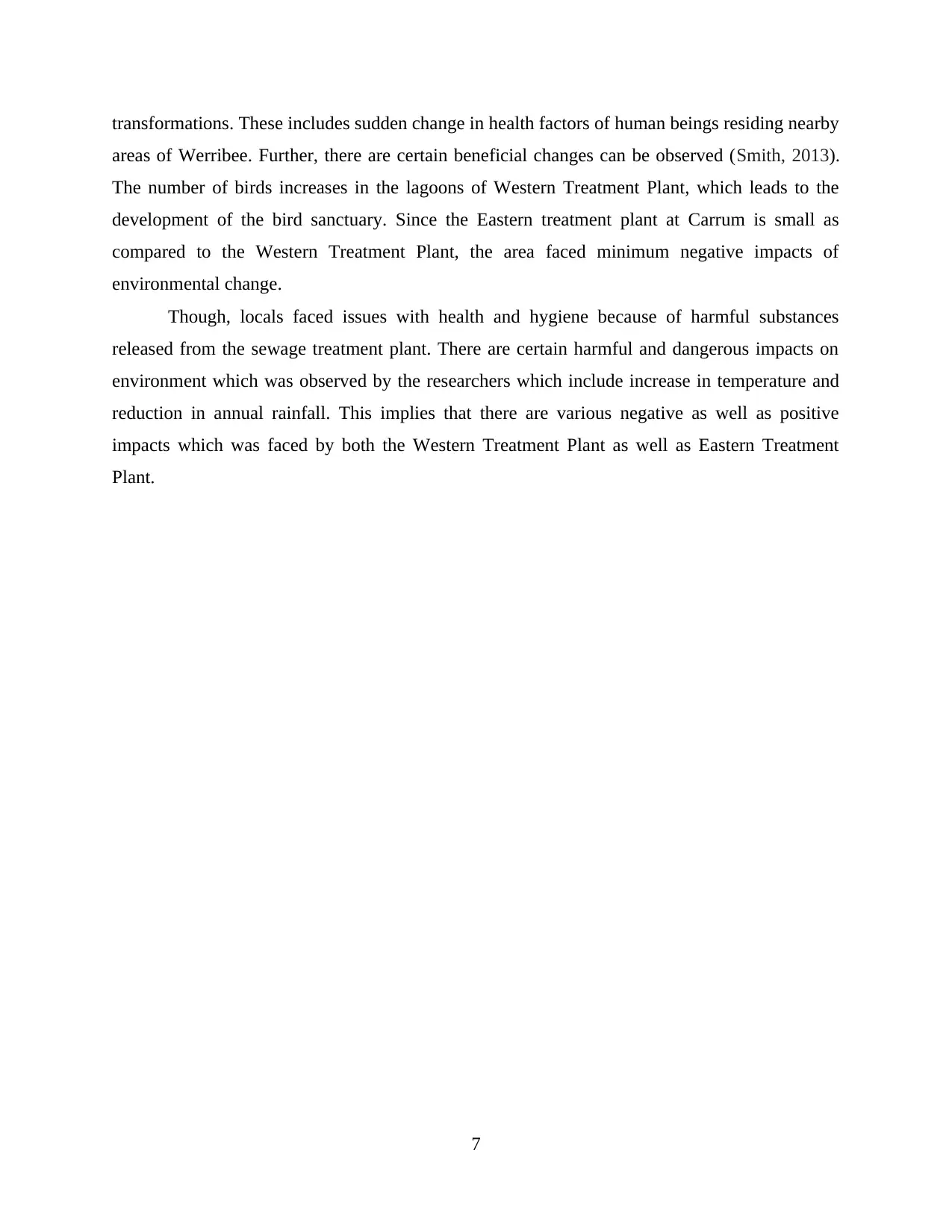
transformations. These includes sudden change in health factors of human beings residing nearby
areas of Werribee. Further, there are certain beneficial changes can be observed (Smith, 2013).
The number of birds increases in the lagoons of Western Treatment Plant, which leads to the
development of the bird sanctuary. Since the Eastern treatment plant at Carrum is small as
compared to the Western Treatment Plant, the area faced minimum negative impacts of
environmental change.
Though, locals faced issues with health and hygiene because of harmful substances
released from the sewage treatment plant. There are certain harmful and dangerous impacts on
environment which was observed by the researchers which include increase in temperature and
reduction in annual rainfall. This implies that there are various negative as well as positive
impacts which was faced by both the Western Treatment Plant as well as Eastern Treatment
Plant.
7
areas of Werribee. Further, there are certain beneficial changes can be observed (Smith, 2013).
The number of birds increases in the lagoons of Western Treatment Plant, which leads to the
development of the bird sanctuary. Since the Eastern treatment plant at Carrum is small as
compared to the Western Treatment Plant, the area faced minimum negative impacts of
environmental change.
Though, locals faced issues with health and hygiene because of harmful substances
released from the sewage treatment plant. There are certain harmful and dangerous impacts on
environment which was observed by the researchers which include increase in temperature and
reduction in annual rainfall. This implies that there are various negative as well as positive
impacts which was faced by both the Western Treatment Plant as well as Eastern Treatment
Plant.
7
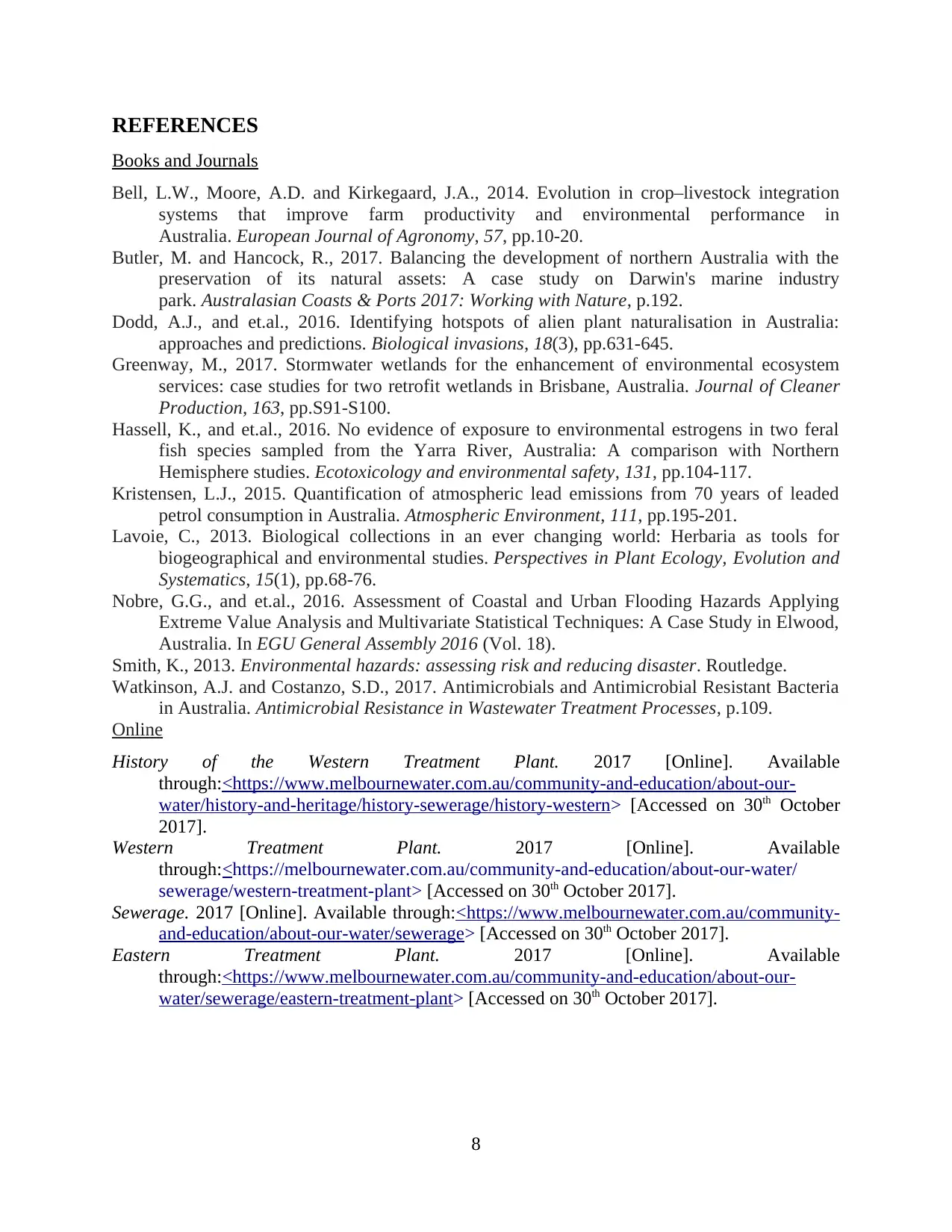
REFERENCES
Books and Journals
Bell, L.W., Moore, A.D. and Kirkegaard, J.A., 2014. Evolution in crop–livestock integration
systems that improve farm productivity and environmental performance in
Australia. European Journal of Agronomy, 57, pp.10-20.
Butler, M. and Hancock, R., 2017. Balancing the development of northern Australia with the
preservation of its natural assets: A case study on Darwin's marine industry
park. Australasian Coasts & Ports 2017: Working with Nature, p.192.
Dodd, A.J., and et.al., 2016. Identifying hotspots of alien plant naturalisation in Australia:
approaches and predictions. Biological invasions, 18(3), pp.631-645.
Greenway, M., 2017. Stormwater wetlands for the enhancement of environmental ecosystem
services: case studies for two retrofit wetlands in Brisbane, Australia. Journal of Cleaner
Production, 163, pp.S91-S100.
Hassell, K., and et.al., 2016. No evidence of exposure to environmental estrogens in two feral
fish species sampled from the Yarra River, Australia: A comparison with Northern
Hemisphere studies. Ecotoxicology and environmental safety, 131, pp.104-117.
Kristensen, L.J., 2015. Quantification of atmospheric lead emissions from 70 years of leaded
petrol consumption in Australia. Atmospheric Environment, 111, pp.195-201.
Lavoie, C., 2013. Biological collections in an ever changing world: Herbaria as tools for
biogeographical and environmental studies. Perspectives in Plant Ecology, Evolution and
Systematics, 15(1), pp.68-76.
Nobre, G.G., and et.al., 2016. Assessment of Coastal and Urban Flooding Hazards Applying
Extreme Value Analysis and Multivariate Statistical Techniques: A Case Study in Elwood,
Australia. In EGU General Assembly 2016 (Vol. 18).
Smith, K., 2013. Environmental hazards: assessing risk and reducing disaster. Routledge.
Watkinson, A.J. and Costanzo, S.D., 2017. Antimicrobials and Antimicrobial Resistant Bacteria
in Australia. Antimicrobial Resistance in Wastewater Treatment Processes, p.109.
Online
History of the Western Treatment Plant. 2017 [Online]. Available
through:<https://www.melbournewater.com.au/community-and-education/about-our-
water/history-and-heritage/history-sewerage/history-western> [Accessed on 30th October
2017].
Western Treatment Plant. 2017 [Online]. Available
through:<https://melbournewater.com.au/community-and-education/about-our-water/
sewerage/western-treatment-plant> [Accessed on 30th October 2017].
Sewerage. 2017 [Online]. Available through:<https://www.melbournewater.com.au/community-
and-education/about-our-water/sewerage> [Accessed on 30th October 2017].
Eastern Treatment Plant. 2017 [Online]. Available
through:<https://www.melbournewater.com.au/community-and-education/about-our-
water/sewerage/eastern-treatment-plant> [Accessed on 30th October 2017].
8
Books and Journals
Bell, L.W., Moore, A.D. and Kirkegaard, J.A., 2014. Evolution in crop–livestock integration
systems that improve farm productivity and environmental performance in
Australia. European Journal of Agronomy, 57, pp.10-20.
Butler, M. and Hancock, R., 2017. Balancing the development of northern Australia with the
preservation of its natural assets: A case study on Darwin's marine industry
park. Australasian Coasts & Ports 2017: Working with Nature, p.192.
Dodd, A.J., and et.al., 2016. Identifying hotspots of alien plant naturalisation in Australia:
approaches and predictions. Biological invasions, 18(3), pp.631-645.
Greenway, M., 2017. Stormwater wetlands for the enhancement of environmental ecosystem
services: case studies for two retrofit wetlands in Brisbane, Australia. Journal of Cleaner
Production, 163, pp.S91-S100.
Hassell, K., and et.al., 2016. No evidence of exposure to environmental estrogens in two feral
fish species sampled from the Yarra River, Australia: A comparison with Northern
Hemisphere studies. Ecotoxicology and environmental safety, 131, pp.104-117.
Kristensen, L.J., 2015. Quantification of atmospheric lead emissions from 70 years of leaded
petrol consumption in Australia. Atmospheric Environment, 111, pp.195-201.
Lavoie, C., 2013. Biological collections in an ever changing world: Herbaria as tools for
biogeographical and environmental studies. Perspectives in Plant Ecology, Evolution and
Systematics, 15(1), pp.68-76.
Nobre, G.G., and et.al., 2016. Assessment of Coastal and Urban Flooding Hazards Applying
Extreme Value Analysis and Multivariate Statistical Techniques: A Case Study in Elwood,
Australia. In EGU General Assembly 2016 (Vol. 18).
Smith, K., 2013. Environmental hazards: assessing risk and reducing disaster. Routledge.
Watkinson, A.J. and Costanzo, S.D., 2017. Antimicrobials and Antimicrobial Resistant Bacteria
in Australia. Antimicrobial Resistance in Wastewater Treatment Processes, p.109.
Online
History of the Western Treatment Plant. 2017 [Online]. Available
through:<https://www.melbournewater.com.au/community-and-education/about-our-
water/history-and-heritage/history-sewerage/history-western> [Accessed on 30th October
2017].
Western Treatment Plant. 2017 [Online]. Available
through:<https://melbournewater.com.au/community-and-education/about-our-water/
sewerage/western-treatment-plant> [Accessed on 30th October 2017].
Sewerage. 2017 [Online]. Available through:<https://www.melbournewater.com.au/community-
and-education/about-our-water/sewerage> [Accessed on 30th October 2017].
Eastern Treatment Plant. 2017 [Online]. Available
through:<https://www.melbournewater.com.au/community-and-education/about-our-
water/sewerage/eastern-treatment-plant> [Accessed on 30th October 2017].
8
⊘ This is a preview!⊘
Do you want full access?
Subscribe today to unlock all pages.

Trusted by 1+ million students worldwide

9
1 out of 10
Your All-in-One AI-Powered Toolkit for Academic Success.
+13062052269
info@desklib.com
Available 24*7 on WhatsApp / Email
![[object Object]](/_next/static/media/star-bottom.7253800d.svg)
Unlock your academic potential
Copyright © 2020–2025 A2Z Services. All Rights Reserved. Developed and managed by ZUCOL.


